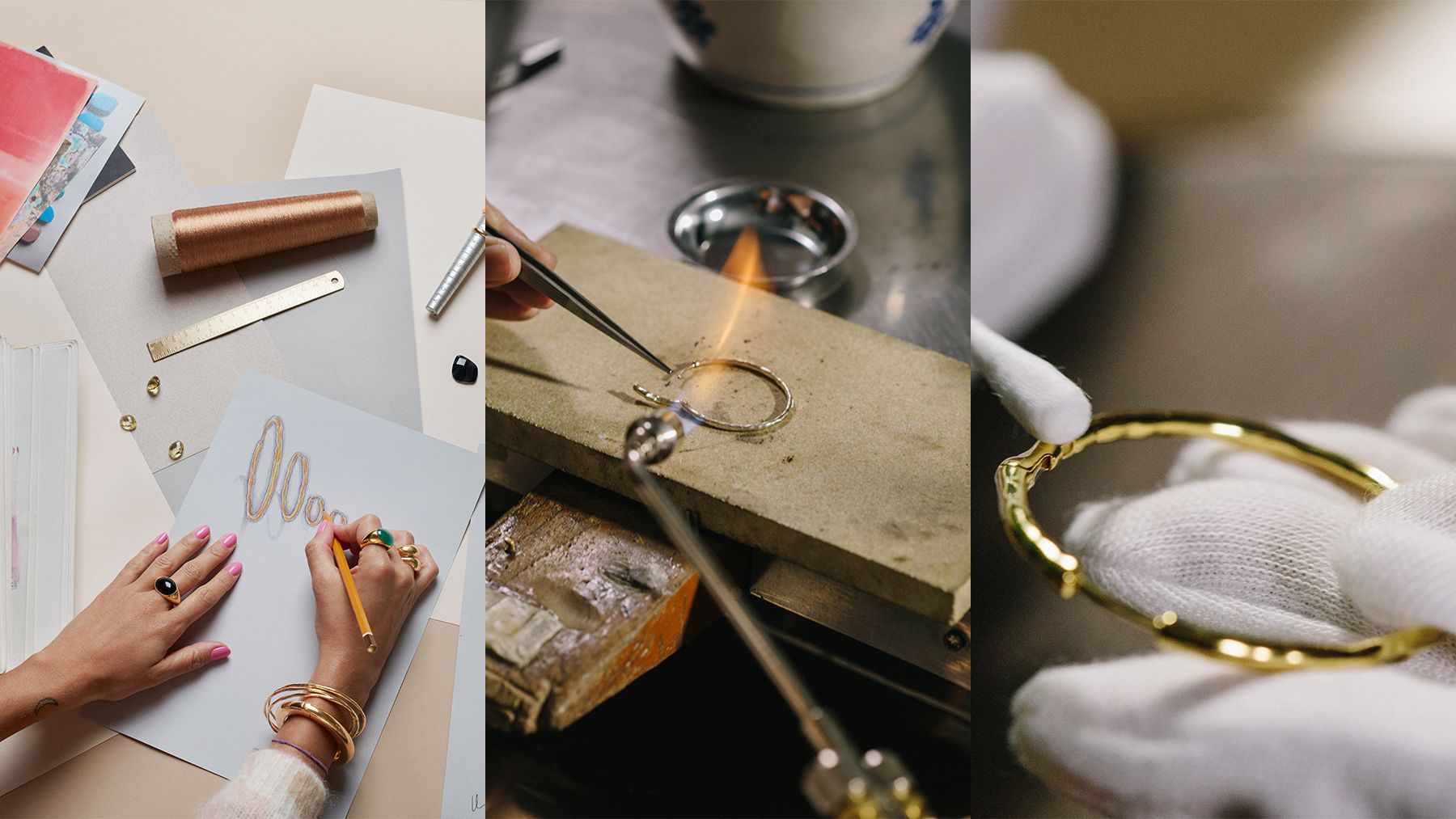
“We’re sticking our neck out,” said jeweller Monica Vinader, describing her namesake brand’s plan to start disclosing all its suppliers.
This week, the British label known for its cord friendship bracelets, stackable rings and minimalistic chain necklaces is rolling out digital passports that will tell consumers exactly where the brand’s products were crafted at each step along the chain.
It’s a level of transparency that remains rare in the jewellery industry, where tracing products all the way back to the mine is notoriously difficult and companies still guard their suppliers like trade secrets despite growing pressure from consumers to prove glitzy gems aren’t linked to nasty human rights abuses and environmental degradation. Russia’s war with Ukraine has given the issue a sharper edge, with gold and diamonds from the country now the subject of sanctions.
Now, change is coming, but slowly. While blockchain-backed traceability initiatives like the one Monica Vinader is rolling out have been in development for years, with major brands touting the technology as a way to offer a tamper-proof digital record of a stone’s journey and efficiently communicate it to consumers, uptake remains limited, technological rollout nascent and disclosure narrow.
The scale of the challenge is reflected in Vinader’s new project. At launch, the programme will cover just 50 products. All are made from recycled precious metals, avoiding the trickier challenge of tracing the origins of gems, and come from a single manufacturer willing to open up its supply chain. The goal is to add products containing selected gems and other materials by late next year, the company said. The ultimate ambition is to track and disclose all suppliers.
“It’s a very archaic industry, and just getting people to be transparent is a struggle. They’re not comfortable,” said Vinader. “It’s a process of us getting to know exactly where our materials come from… [but] we’re going to name all of them.”
A Long Road to Transparency
For Vinader, it’s been a decade-long journey just to get to this point, working to get better visibility of the brand’s supply chain and partnering with producers willing to push the bounds of industry best practices. Even so, big hurdles remain.
“It’s been 10 years of work,” said Vinader. “There’s no shortcut. It’s a process, you can’t just click your fingers and become something else.”
While a growing number of blockchain-based tools to track and manage apparel and jewellery supply chains are emerging, it still requires a lot of work and investment to develop the supply-chain visibility, relationships and collaboration required to onboard the technology at every stage.
Just getting people to be transparent is a struggle.
Vinader’s programme is a partnership with sustainability-focused Thai manufacturer Ennovie, which had proposed developing passports to clients as an engaging way to talk about supply-chain sustainability initiatives.
When push came to shove, almost none wanted to take a punt on an unproven tech product, and the idea of disclosing suppliers got shut down even more quickly. Vinader heard the idea and shifted more production over to Ennovie to help make it happen.
“Monica took a different approach… [and] a big risk,” said Ennovie chief executive Raphael Galdini. “They really took massive steps to make the project happen without any guarantees from our side.”
It still took 18 months to get all the suppliers involved on board, both from a tech perspective and in terms of the time needed to overcome resistance to supply-chain disclosure. In fact, the back-end tech — which didn’t exist a year-and-a-half ago — was probably the easiest part, said Galdini.
Hurdles Ahead
Moving to the next phase of the project is exponentially more challenging. Monica Vinader’s supply chain through Ennovie is relatively short and well-established. The recycled gold and silver come from one of two refineries in Thailand or Italy, passing through a producer also in Italy before reaching Ennovie, where it is crafted into the final product.
Figuring out where the brand’s gemstones, diamonds and pearls come from is harder and will mean convincing a broader swathe of suppliers to get involved.
Most coloured stones pass through the many hands of miners, sorters, cutters, polishers and merchants before landing in a piece of jewellery. The fragmented nature of their production, and the fact most originate in myriad small mines around the world, makes them particularly difficult to trace.
More companies are able to offer details about where diamonds might come from, thanks in part to decades of scrutiny fuelled by concerns over conflict stones, as well as the small number of mining companies that control the vast majority of the world’s supply. But the focus has been on more valuable, larger stones, not the smaller diamonds Monica Vinader uses in her more accessibly priced, demi-fine jewellery.
By late next year, Vinader aims to add products containing semi-precious stones to the passport programme, tracing them back to the mine where they were produced. So far, the brand has visibility for turquoise, black onyx and some green onyx.
“It’s been tough,” said Vinader. “I don’t know what we’re going to do with diamonds because small diamonds are batched, and the batches are mixed, and if I can’t identify the batch with a mine, I don’t think I can put it on a passport.”
An Imperfect Solution
Even then, the project has inherent limits. While blockchain guarantees a tamper-proof record, it requires work behind the scenes to ensure the information is accurate, particularly when it comes to any sustainability claims.
“Traceability is a tool,” said Dr. Laurent Cartier, co-founder of the Gemstones and Sustainable Development Knowledge Hub. “If you tell me the wine is French, what that does is tell me that the wine is French. Traceability doesn’t in itself prove a sustainable contribution.”
There’s no shortcut. It’s a process, you can’t just click your fingers and become something else.
To be effective, such efforts need to be coupled with robust assurances that each step in the supply chain is indeed operating responsibly. The challenge is that the standards and certifications that govern the jewellery industry are of varying maturity and have themselves come under heavy criticism for failing to effectively prevent abuses.
It’s a challenge Vinader and her partners recognise. For now, customers will be able to see the certifications each factory has achieved when they navigate through an item’s production journey. In the long term, the goal is to keep pushing beyond the current frameworks to put in place more robust systems to establish and verify the full supply chain is operating to the expected standards.
“I’m under no illusions: no certification is perfect,” said Vinader. “I’m interested in setting higher standards for supply chain transparency.”
Moving the Needle
Vinader’s project is one in an evolving field that is gradually bringing change to a cautious and conservative industry.
De Beers has begun to roll out a blockchain-backed service for diamond traceability after four years of development. Luxury giants including Prada, Cartier and LVMH came together last year to form the Aura Blockchain Consortium, a shared platform for luxury brands looking to develop tamper-proof digital ledgers with information like authenticity, maintenance and provenance of materials.
How the industry deploys this more widely and what gets communicated to consumers who have an ambiguous relationship with sustainability remains to be seen.
“Lots of people are saying this does matter to them, but very few are acting as though it matters to them,” said Alexander Thiel, a partner at consultancy McKinsey & Co. “This is something that takes, from a brand point of view, a lot of effort at significant cost, while not really giving significant differentiation in the marketplace.”
Vinader said it’s impossible to quantify the investment it’s taken just to get to this point, both financially and in terms of her team’s time. But for her brand and the values she wants it to reflect, she believes it will pay off in terms of market positioning.
“I want people to realise the pieces they’re putting on have an intrinsic value; it’s come from the earth,” said Vinader. “This is not a throwaway thing. This is something you consciously need to wear and use.” The brand’s sales rose 38 percent to hit £80 million ($91.76 million) in the year ended July 31.
“I think it would be so incredibly irresponsible to grow and not have these practices,” Vinader said. “This is a way of shining a light on this for me, for my suppliers, for customers. And hopefully others will think of this as best practice.”
For more BoF sustainability coverage, sign up now for our Weekly Sustainability Briefing by Sarah Kent.



